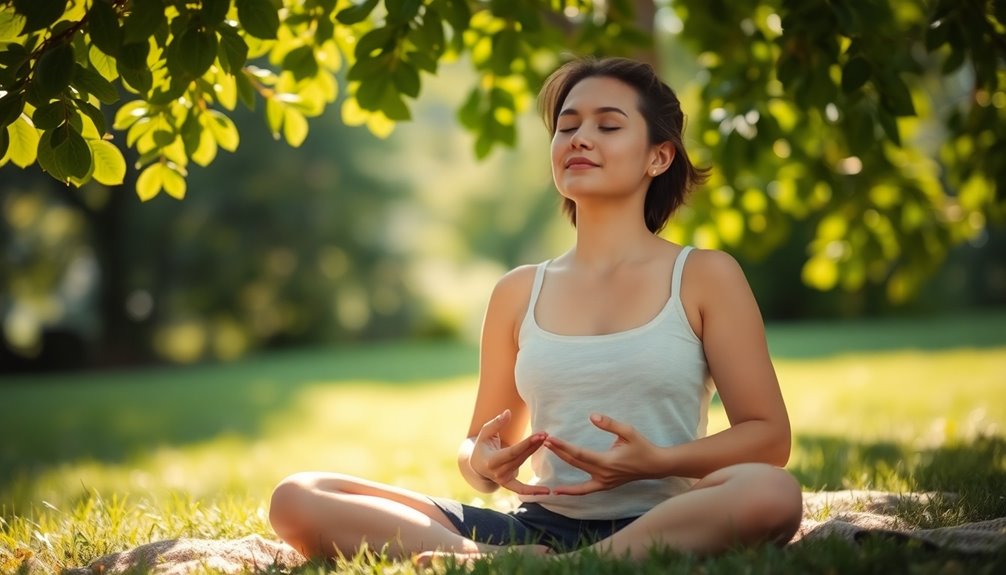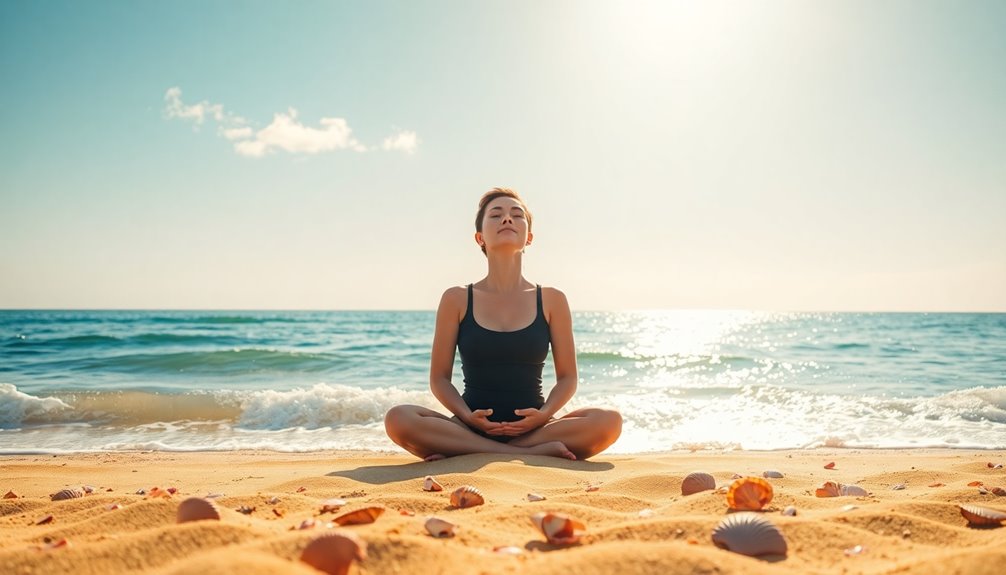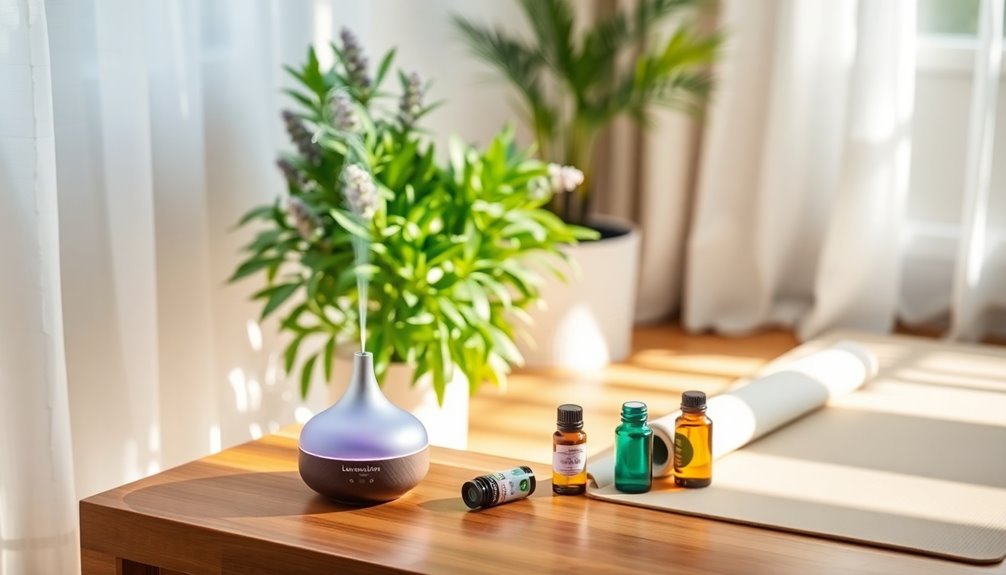You can easily combat stress anytime and anywhere with these 10 practical techniques. Start with deep breathing exercises to ground yourself, or try mindful meditation to enhance emotional health. Progressive muscle relaxation is great for easing tension, while quick desk stretches revive your body. Listening to nature sounds can reduce anxiety and help you focus. Incorporating simple aromatherapy with essential oils can uplift your spirits, and using positive affirmations can reshape your thoughts. Light physical activity, like a quick walk, boosts your mood. Keep exploring, and you'll discover even more ways to reduce stress effortlessly!
Key Takeaways
- Practice deep breathing exercises like the 4-7-8 method to calm your mind and lower heart rate anywhere you are.
- Engage in mindful meditation for a few minutes to enhance emotional health and cultivate peace amidst chaos.
- Use progressive muscle relaxation techniques to release tension and promote a deep sense of calm, even in stressful environments.
- Listen to nature sounds to create a calming atmosphere and reduce anxiety, enhancing your focus and connection to nature.
- Keep a gratitude journal to foster a mindset of abundance, boosting your emotional well-being wherever you may be.
Deep Breathing Exercises

When you're feeling overwhelmed, deep breathing exercises can be a powerful tool to regain your calm. These simple yet effective breathing techniques help ground you in the present moment, making it easier to manage stress. You don't need any special equipment or a quiet space; you can practice these relaxation methods anytime, anywhere.
Start by finding a comfortable position. You can sit or stand, just make sure your back is straight. Close your eyes if it feels right, and take a slow, deep breath in through your nose, allowing your abdomen to expand. Hold that breath for a moment, then gently exhale through your mouth, letting all the tension flow out. Repeat this process a few times. You'll notice that with each exhale, your body feels a little lighter.
Another effective technique is the 4-7-8 method. Inhale deeply for a count of four, hold your breath for seven seconds, and then exhale for eight seconds. This pattern not only helps calm your mind but also lowers your heart rate. Incorporating these techniques can enhance your overall well-being by promoting a strong core, which is essential for effective stress management.
Mindful Meditation

Mindful meditation offers a transformative way to cultivate awareness and presence in your daily life. By taking just a few minutes each day, you can harness the power of mindful breathing to reduce stress, enhance focus, and foster emotional well-being. It's an accessible practice that connects you to the moment, allowing you to step back, breathe, and simply be. Engaging in this practice can also help optimize your nervous system for better performance throughout your day.
Here's a quick overview of some meditation benefits and how to integrate them into your routine:
| Meditation Benefits | How to Practice |
|---|---|
| Reduces stress | Find a quiet space |
| Improves focus | Sit comfortably |
| Enhances self-awareness | Close your eyes |
| Boosts emotional health | Breathe deeply and slowly |
| Increases compassion | Acknowledge your thoughts |
To get started, choose a comfortable position—sitting or lying down works well. Close your eyes, and begin with a few minutes of mindful breathing. Inhale deeply through your nose, feeling your chest rise. Exhale slowly through your mouth, letting go of tension. As thoughts arise, notice them without judgment and gently return your focus to your breath.
Progressive Muscle Relaxation

Progressive muscle relaxation (PMR) is a powerful technique that helps you release tension and promote a deep sense of calm. By systematically tensing and then relaxing different muscle groups in your body, you can create a profound feeling of muscle relaxation that alleviates stress and anxiety. It's a simple practice you can do anywhere, making it a great addition to your stress-relief toolkit. Additionally, incorporating practices that enhance brain health can further support your overall well-being.
Here's a quick guide to get you started with PMR:
- Find a comfortable position: Sit or lie down in a quiet space where you won't be disturbed.
- Focus on your breath: Take a few deep breaths, inhaling through your nose and exhaling through your mouth to calm your mind.
- Work through each muscle group: Starting from your toes, tense each muscle group for about five seconds, then release and feel the tension melt away. Move up through your body—feet, legs, abdomen, arms, and face.
As you practice PMR, you'll notice the tension release and a growing sense of relaxation. This technique not only helps with physical stress but also enhances your emotional well-being, creating a sense of belonging and connection to your body.
Quick Stretching Techniques

In just a few minutes, you can incorporate quick stretching techniques into your daily routine to release built-up tension and enhance your overall well-being. These simple movements can be done at your desk or in a chair, making them perfect for anyone feeling the weight of stress during a busy day.
Start with desk stretches to alleviate tension in your neck and shoulders. Sit up straight, and gently tilt your head to one side, holding for 15-30 seconds. Repeat on the other side.
Next, roll your shoulders back and down, taking a deep breath as you do so. This will help open up your chest and improve your posture.
If you're seated, chair yoga is an excellent way to stretch without needing to leave your workspace. Try the seated cat-cow stretch: sit at the edge of your chair, arch your back, and lift your chest for the cow pose; then, round your back and tuck your chin for the cat pose. Repeat this for a minute to feel the tension melt away.
Don't forget your wrists and hands, especially if you're typing a lot. Extend one arm in front of you, palm up, and gently pull back on your fingers with the opposite hand. Hold this stretch for 15 seconds, then switch sides. Incorporating these stretches can also complement your fitness routine, enhancing results from activities like mini band workouts.
Visualization Practices

Visualization practices can be a powerful tool for reducing stress and enhancing your mental well-being. By engaging in techniques like guided imagery and creative visualization, you can transport yourself to calming places and cultivate a sense of peace, even amidst chaos.
Here are three simple visualization techniques you can try:
- Guided Imagery: Close your eyes and picture a serene environment, like a beach or a quiet forest. Focus on the details: the sound of waves, the warmth of the sun, or the rustle of leaves. Allow yourself to feel as if you're truly there, letting the tranquility wash over you.
- Creative Visualization: Imagine achieving a goal that excites you. Whether it's acing a presentation or enjoying a peaceful moment, visualize every step you'd take to get there. See the vibrant details and feel the emotions associated with your success. This not only reduces stress but also motivates you.
- Color Breathing: Visualize a calming color filling your body as you inhale and stress leaving as you exhale. Choose a soothing hue like blue or green. Each breath enhances your relaxation, creating a vivid mental image that can ground you in challenging situations. Additionally, using techniques like brainwave guidance can further enhance your visualization practice by facilitating deeper states of relaxation.
Gratitude Journaling

Cultivating gratitude can transform your perspective and boost your overall well-being. One effective way to do this is through gratitude journaling, a simple yet powerful practice that encourages daily reflections on what you appreciate in your life. By taking just a few minutes each day to jot down these thoughts, you create a positive habit that fosters contentment and resilience.
Start by choosing a dedicated journal or even a digital note-taking app where you can easily record your entries. Each day, set aside time—perhaps in the morning or before bed—to reflect on three to five things you're grateful for. These can be big or small, from the support of a friend to the warmth of a sunny day. The key is to be specific and genuine in your gratitude practice.
As you write, try to immerse yourself in the feelings associated with these positive moments. This not only enhances your emotional well-being but also helps you cultivate a mindset of abundance rather than scarcity. Over time, you'll likely notice a shift in how you perceive challenges and stressors in your life.
Gratitude journaling doesn't require a lot of time or resources, making it an accessible technique for anyone. When you make it a habit, you'll strengthen your sense of belonging and connection to yourself and others. So grab that pen or open your app, and start your journey toward a more grateful and fulfilled life today!
Nature Sounds Listening

Listening to nature sounds regularly can be a simple yet effective way to reduce stress and enhance your mood. Whether you're in your office, at home, or outdoors, immersing yourself in the sounds of nature can create a calming atmosphere that promotes outdoor mindfulness. Think about how the gentle rustling of leaves, the melodic chirping of birds, or the soothing flow of a stream can transport you to a peaceful place.
Here are three powerful benefits of nature sounds:
- Reduced Anxiety: Nature sounds can lower cortisol levels, helping you feel more relaxed. Just a few minutes of listening can ease your mind and body.
- Enhanced Focus: The rhythmic patterns of nature sounds can improve concentration, making it easier to tackle tasks without distractions.
- Connection to Nature: Engaging with these sounds can foster a sense of belonging to the natural world, even if you're indoors. You might feel like you're part of a larger ecosystem, which is grounding and comforting.
For an even more immersive experience, consider practicing forest bathing. This practice encourages you to engage all your senses while being surrounded by nature, enhancing your connection to the environment.
Simple Aromatherapy Tips

Aromatherapy offers a delightful way to enhance your well-being and combat stress. You don't need to be an expert to enjoy its benefits; simple DIY essential oils can easily become part of your daily routine. Start by selecting calming scents like lavender, chamomile, or bergamot. These fragrances are known for their relaxing properties and can help create a peaceful environment wherever you are.
To make your own essential oil blends, combine a few drops of your chosen oils with a carrier oil, like sweet almond or jojoba. You can apply this blend to your wrists or behind your ears for an instant mood boost.
If you prefer something portable, consider making a calming scent roll-on. Mix your essential oils with a carrier oil in a small glass roller bottle, and whenever you feel stressed, roll it on your pulse points.
Another easy way to incorporate aromatherapy into your life is through diffuser necklaces or bracelets. These pieces allow you to wear your favorite calming scents and enjoy their benefits throughout your day.
If you're in a space where you can use a diffuser, simply add a few drops of your chosen essential oils and let the mist fill the room.
Positive Affirmations

In addition to the soothing power of scents, incorporating positive affirmations into your daily routine can greatly enhance your mental well-being. Positive affirmations are like daily mantras that can help you reshape your thoughts and beliefs. By practicing empowering self-talk, you can cultivate a more positive mindset and reduce stress.
To get started, try these three impactful affirmations:
- I am enough. Remind yourself that you possess the strength and qualities needed to face any challenge.
- I deserve happiness. Embrace your right to joy and fulfillment, allowing yourself to pursue what brings you peace.
- I'm in control of my thoughts. Recognize that you have the power to choose how you respond to situations, steering your mind toward positivity.
You can easily make affirmations a part of your day. Whether you say them aloud while getting ready in the morning or write them down in a journal, consistency is key. You'll find that these daily mantras can shift your perspective and empower you to handle stress more effectively.
Surrounding yourself with a supportive community can amplify the benefits of positive affirmations. Share your affirmations with friends or family, and encourage them to join you in this uplifting practice. Remember, you're not alone on this journey toward mental well-being. By embracing positive affirmations, you're taking a powerful step towards a happier, more connected life.
Light Physical Activity

Finding balance in life often requires incorporating light physical activity into your routine. When you're feeling stressed, engaging in simple movements can help you invigorate your mind and body. Whether it's a few minutes of desk yoga or a quick outdoor walk, these activities can make a significant difference in how you feel throughout the day.
Here's a quick guide to light physical activities that can easily fit into your schedule:
| Activity | Benefits |
|---|---|
| Desk Yoga | Relieves tension, improves posture |
| Outdoor Walks | Boosts mood, increases energy |
| Stretching | Enhances flexibility, reduces aches |
| Deep Breathing | Calms the mind, lowers heart rate |
| Quick Chair Exercises | Strengthens muscles, increases circulation |
You don't need a gym or special equipment to incorporate these activities into your day. For instance, desk yoga can be done right at your workstation, helping to alleviate the stiffness that comes from sitting for too long. Just a few stretches or poses can greatly enhance your focus.
Outdoor walks serve as a fantastic way to clear your mind and connect with nature. Even a short stroll can be invigorating, especially if you take it during a break. So why not take a few moments each day to engage in these light physical activities? You'll find that they not only help reduce stress but also foster a sense of community as you connect with others who share similar practices.
Frequently Asked Questions
Can These Techniques Be Used Together for Better Results?
Absolutely, you can combine stress-relief techniques for enhanced benefits. By integrating various methods, you boost your stress management efforts and tap into the mind-body connection. This holistic approach not only amplifies relaxation but also fosters a sense of belonging as you explore what works best for you.
Experimenting with combinations allows you to discover unique pathways to calmness, ultimately leading to a more balanced and fulfilling life. So, go ahead and mix them up!
How Long Should I Practice These Techniques Daily?
You might be wondering how long you should devote to these techniques for the most favorable results. The ideal duration is around 10 to 20 minutes daily. By incorporating techniques consistently, you'll access maximum benefits over time. Start with shorter sessions and gradually increase as you become more comfortable.
This daily practice not only helps manage stress but also fosters a sense of belonging and connection to yourself and others. Stick with it, and you'll see progress!
Are There Any Side Effects From These Stress-Relief Methods?
When considering stress-relief methods, it's important to be aware of potential risks. While most techniques are safe, some might cause discomfort or exacerbate anxiety for certain individuals. Always listen to your body—if something doesn't feel right, stop.
Additionally, keep in mind the health implications of any sudden lifestyle changes. Finding what works best for you can make a big difference in managing stress effectively while ensuring your overall well-being.
Can Children Practice These Techniques Effectively?
Yes, children can practice these techniques effectively! You'll find child-friendly techniques that make stress relief fun and engaging. By using age-appropriate exercises, you help them learn to manage their emotions. The benefits include improved focus and a sense of calm. Encouraging your child to try these methods not only fosters independence but also strengthens your bond.
You'll be amazed at how quickly they grasp these skills and feel more in control!
Where Can I Find Resources for Guided Sessions?
Ever felt like you're submerged in stress? You're not alone! To find resources for guided sessions, start exploring online platforms and mindfulness apps. They offer a variety of sessions tailored to your needs.
Additionally, consider joining well-being workshops or attending wellness retreats. These experiences not only provide guidance but also create a sense of belonging with others on the same journey.
Plunge into and discover what resonates with you!
Conclusion
Incorporating these stress-relief techniques into your daily routine can transform your well-being. Imagine taking a deep breath while visualizing a serene landscape, or stretching as you listen to calming nature sounds. These practices aren't just quick fixes; they're tools you can use anytime, anywhere. So, whether you're at your desk or in a park, remember that relief is just a breath away. Embrace these methods, and watch stress melt away like snow under the sun.



